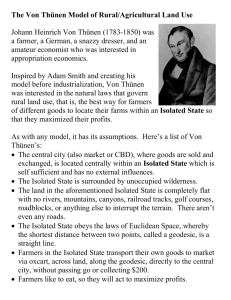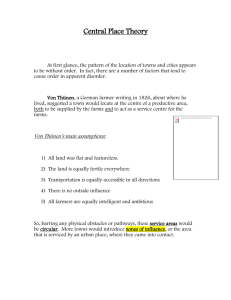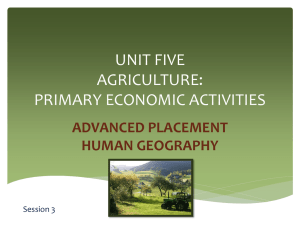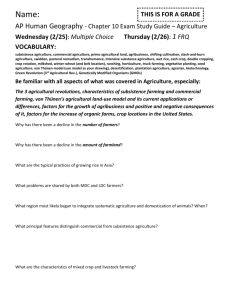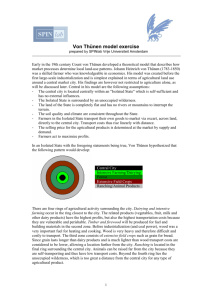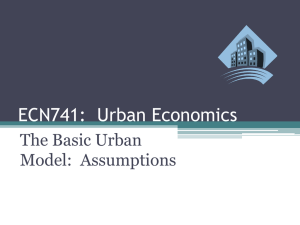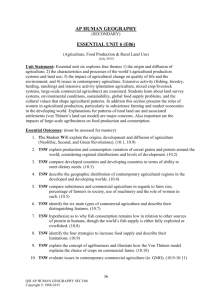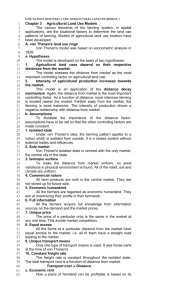Thünen and the New Economic Geography
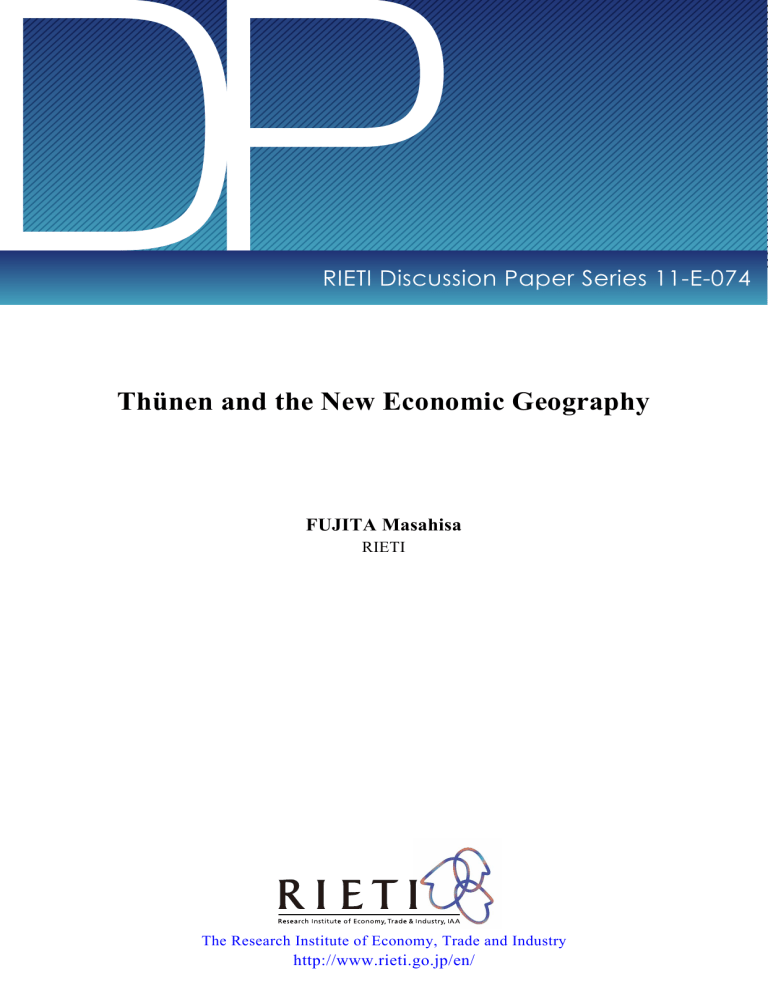
DP
RIETI Discussion Paper Series 11-E-074
Thünen and the New Economic Geography
FUJITA Masahisa
RIETI
The Research Institute of Economy, Trade and Industry
http://www.rieti.go.jp/en/
RIETI Discussion Paper Series 11-E-074
November 2011
Thünen and the New Economic Geography
*
FUJITA Masahisa
**
Abstract
In this paper, I explain Thünen’s pioneering work on industrial agglomeration. In my opinion, Thünen’s thinking on industrial agglomeration was not only amazingly advanced for his time, but in many respects remains novel even today. It is shown that if we unify
Thünen’s well-known theory on agricultural land use with this pioneering work on industrial agglomeration by using modern tools, then we essentially come up with a prototype of New Economic Geography model.
JEL Classification Number s: R10, Q10, D50.
Keywords : Thünen, cities, new economic geography
RIETI Discussion Papers Series aims at widely disseminating research results in the form of professional papers, thereby stimulating lively discussion. The views expressed in the papers are solely those of the author(s), and do not represent those of the Research
Institute of Economy, Trade and Industry.
* This paper is based on lecture notes presented at the International Thünen Conference
2000, on the occasion of the 150th anniversary of Johann Heinrich von Thünen’s death, the
University of Rostock, September 21-24, 2000. I would like to thank Jacques Thisse, Ikeda
Maria P. Makabenta, and two anonymous referees for helpful comments on earlier drafts of this paper. I am also grateful to Grants-in-Aid for Scientific Research Grant A 18203016
(from the Japanese Ministry of Education and Science) for financial support.
** Research Institute of Economy, Trade and Industry, Tokyo. Correspondence to Masahisa
Fujita, Research Institute of Economy, Trade and Industry, 1-3-1 Kasumigaseki,
Chiyoda-ku, Tokyo 100-8901, Japan, Phone: 81-3-35-1-1361, Fax: 81-3-3501-8391, E-mail: fujita-masahisa@rieti.go.jp.
“Wherever economic theory is studied today, his ideas, his working methods, the problems he posed, have proved seminal right up to the present day–even there, where his name seems to have been forgotten, Thünen has worked. His work shines brighter than ever today. Much, which seems self-evident to us, goes back to him.
And still not all the riches which are buried in his work are brought to light. To fi nd them, you must without doubt read The Isolated State carefully and often.”(Erich
Schneider, 1959, p. 27-8)
1
1 Introduction
According to Paul Samuelson in 1983 in his commemorative paper at the two— hundredth anniversary of Thünen’s birth, Thünen “not only created marginalism and managerial economics , but also elaborated one of the fi rst models of general equilibrium and did so in terms of realistic econometric parameters.”(Samuelson, 1983, p.1468, emphases by the original author) More speci fi cally, Samuelson asserts that
“Thünen’s model has in it elements of all of the following systems:
1. The Ricardo—Torrens theory of comparative advantage.
2. The Malthus—West—Ricardo theory of rent.
3. The Hecksher—Ohlin and Stolper—Samuelson theory of factors—and—goods pricing.
4. The Marx—Dimitriev—Leontief—Sra ff a system of input—output.” (p. 1481)
This is praise so grand that no other economist in history, except possibly Adam
Smith, could possibly deserve it. As a location theorist myself, however, I would like to emphasize in this paper that from the viewpoint of location theory, Thünen’s work contains more than that. In addition to the four elements cited above by Samuelson,
I would like to note that in his later work, Thünen also anticipates the following theories:
1
This quotation is from Schneider (1959) which was written to honour Thünen’s name on the
175th anniversary of his birth in 1958. The English translation quoted here is from the Introduction by Peter Hall to the English translation of von Thünen (1826) by Wartenberg (1966, p.xliv).
2
5. The Marshall—Weber theory of industrial agglomeration
6. The Christaller—Lösch theory of central place system
7. The recent development of new economic geography
Before elaborating these points in the subsequent sections, let us recall that Thünen was not an ordinary armchair scholar. As is well-known, he never occupied an academic position in his life.
The initial idea of the so called Thünen rings has evolved to a grand theory of the general equilibrium of a spatial economy while he was working on his own Tellow estate, engaging in ceaseless agricultural improvement on his land.
Thünen was satis fi ed with his abstract model only after taking laborious investigations of costs and returns on his Tellow estate over ten years, and then con fi rming that the collected data fi tted directly into his model.
No wonder,
Schumpeter (1954, p.446) called Thünen “one of the patron saints of econometrics.”
In short, Thünen’s timeless model of agricultural land use and rent has been “cultivated on land” literally while he was working as a farmer.
This part of his work on agricultural land use and rent was published as The Isolated State in 1826, later called Part I in order to separate it from later editions.
Today, almost any textbook of economic geography and location theory explains the basic idea of Thünen’s theory on agricultural land use and rent, using a diagram of a monocentric economy illustrated in Figure 1.
Figure 1
Later, the monocentric economy model of Thünen was developed in various forms utilizing modern analytical tools.
2
In particular, Alonso (1964) reinterpreted the
2 For early contributions to a systematic treatment of Thünen’s ideas in fully mathematical form, see Laundhardt (1885, ch.30), Lösch (1940, ch5) and Dunn (1954). It must be noted, however, that the aspect of wage determination of farmers has been completely neglected in almost all subsequent variations of Thünen’s model except in the recent general equilibrium analyses by Samuelson (1983) and Nerlove and Sadka (1991).
3
monocentric economy model of Thünen by substituting commuters for farmers and the central business distinct (CBD) for the town, and generalized Thünen’s central concept of big rent curves to an urban context.
This "monocentric city model" provided modern urban economics with the theoretical foundation.
For a long time, I believed that from the viewpoint of geography and location theory, this was the end of the story. Of course, even if it were so, Thünen’s story is already one of eternal scienti fi c fascination.
Then, a terrible shock came to me when I read recently Section 2 of the so-called Part II of The Isolated State , edited by
Hermann Schumacher and published in 1863, which contains Thünen’s posthumous papers mainly dealing with the problems of spatial economy related to the original
Part I.
3 If I borrow Schneider’s words again, my amazement was that “even there,
Thünen has worked”! “There” means no other than New Economic Geography.
In my opinion, Thünen is indeed "the founding god" of modern economic geography, 4 which includes not only traditional economic geography and location theory,but also the modern urban economics as well as the so-called New Economic Geography.
As explained in the next section, Thünen was concerned not only with the working of the agricultural hinterland surrounding a single town, but also, at least in his later years, concerned with the working of the entire spatial economy including “the order and distribution of towns in the Isolated State.” 5
2 Thünen and agglomeration economies
When we discuss the reasons for the concentration of an industry (or industries) in a speci fi c location, or more generally, the agglomeration of people and industries in a city (or in a system of cities), it has been customary to go back as far as to
3 Actually, I read only extracts of Section 2 because I am unable to read German, and only extracts are available in the English translation by Carla M. Wartenberg (1966).
4 Samuelson (1983, p.1468) notes that "Among geographers and location theorists, Thünen is a founding God."
5 This citation is from the title of Section 2 in Part 2 (Extract) in the English translation by
Wantenberg (1966).
4
Marshall (1890,1920, ch.x), and then to Weber (1921) and Hoover (1936), and to the central place theory of Christaller (1933) and Lösch (1940). To the best of my knowledge, there is no article in the economics literature which associates the topic of agglomeration (or distribution of cities) with Thünen.
6 Location theorists and economic geographers (both “traditional” and “new”) always referred to Thünen, but never in the context of agglomeration economies or city formation. Thus, it is a great surprise to realize that (using Schneider’s words again) “even there, where his name seems to have been forgotten, Thünen has worked”!
To see where Thünen has worked, it may be su ffi cient to glance over the following contents of Part II, Section 2 of the English translation (Wartenberg, 1963), which contain the extracts of posthumous papers on location theory written by Thünen between 1826 and 1842.
7
Part Two, Section Two, ... Subsection 5 Changes in our assumptions (many towns of the same size equi-distant from each other), Subsection 6 The order and distribution of towns in the Isolated State, Subsection 7 The role of population density, Subsection
8 The dynamics of the Isolated State: are there obstacles to its expansion?
Given that I have access only to the extracts of Thünen’s work in this part, I must be careful with what I say here. Nevertheless, let me discuss my understanding of
Thünen’s work with an emphasis on Subsection 6. As we all know, in Part I, Thünen assumed that the Isolated State contained only a single large town. In contrast, in
Subsection 5, Thünen assumes that the plain contains many small towns of the same size located equidistant from each other, and investigates how the size of towns and the distance between them a ff ect the pattern of agricultural production and land rent. However, in this subsection, Thünen does not discuss how the size of each city is determined nor how the distance between cities is decided, which are the main
6 This excludes the overall INTRODUCTION of The Isolated State by Peter Hall in the English translation by Wartenberg (1966), in which Hall notes that "just before his death, he was already reaching out into general location theory, and groping towards concepts which were properly developed by others decades later." (p.xliv)
7 The titles of subsections 1 to 4 are omitted here since they are not related to the present topic of agglomeration.
5
topics in the next subsection.
In Subsection 6, Thünen asks “What determines the relative position of the towns in the Isolated State in respect of size and distance from each other?”(p.285) 8 In studying this fundamental problem, Thünen further divides the problem into a number of more concrete questions.
The fi rst question is about the concentration of people in large towns such as the
Capital. If the (urban) population of the economy were divided among many small towns, then every consumer would be easily accessible to agricultural supply. Thus,
Thünen asks:
“Why then is the population of the large Town not divided among many small ones? The reasons are as follows: In practice, deposits of ore, salt and coal are most unevenly distributed....The focal centre of a country is the natural residence of the head of the goverment:the seat of the highest o ffi ces of justice and administration, of army head quarters, the higher institutes of learning, art collections, etc. The presence of the capital of the court, the concourse of scholars, men of science and state o ffi cials, the theaters, museums, etc., a ff ord many more social attractions and amenities than the provinces could ever o ff er...To cater for the needs and pleasures of all the citizens assembled in the capital for any of these reasons, a great many people of the artisan and service class are required...”(p.286)
In terms of modern urban economics, the fi rst reason refers to fi rst nature, the second to central management functions and public service, the third to social and cultural amenities, and the last to nontradable consumer goods and services. It is interesting to note that if the natural amenities were included in the fi rst factor, then all four factors above have been increasingly emphasized recently as important determinants of population agglomeration in future cities(e.g., Glaeser, 1998). Notice, however, that when Thünen asks the reasons for agglomeration of people in a large town, he does not consider those reasons for the agglomeration of industries and their workers. This is the question he poses next:
“Of far greater importance and di ffi culty is the question:whether industries which draw their raw materials from, and sell most of their products to, the provinces, are also better o ff located in the capital?”(p.286)
8 Each quotation below without the author’s name is from the English translation by Wartenberg(1966).
6
In investigating this question, fi rst he asks "the reasons against the location of industries in the capital," or the centrifugal forces (using the terminology of the New
Economic Geography) against industrial agglomeration. Thünen’s answer is:
"1. Raw materials are more expensive than in the country towns on account of the higher cost of transport. 2. Manufactured articles incur the cost of haulage to the provincial towns when they are distributed to the rural consumers. 3. All necessities, especially fi rewood, are much more expensive in the large town. So is rent for fl ats and houses, for two reasons (1) construction costs are higher because raw materials have to be brought from a distance and are consequently more expensive, and (2) sites that may be bought for a few thalers in a small town are very dear. Since food, as well as fuel and housing, cost so much more in the large town, the wage expressed in money, must be much higher than in the small one. This adds appreciably to production costs.”(pp.286-7)
The consideration of centrifugal forces above is surprisingly comprehensive even in comparison with the recent literature of New Economic Geography. In particular, the e ff ects of high land rents and high food prices on monetary wages in large towns are explicitly considered.
Next, Thünen investigates in depth the centripetal forces of industrial agglomeration:
“The following factors, on the other hand, favour the location of industries in large towns: 1. Only in large-scale industrial plants is it pro fi table to install labour-saving machinery and equipment, which economise on manual labour and make for cheaper and more e ffi cient production.
2. The scale of an industrial plant depends on the demand for its products. 3. The number of buyers depends, in provincial towns, on the number of countrymen coming in to sell their products, or passing through on their way to the capital. For instance, a countryman may visit the capital to sell his products, and decide to buy some liquor. It will be cheaper for him to buy this in the capital, even if it costs him half a thaler more than he would pay in the provincial town two miles from his farm, because he would have to make a special journey to fetch the local alcohol.” 4. For all these reasons, large scale plants are viable only in the capital in many branches of industry. But the division of labour (and Adam
Smith has shown the immense in fl uence this has on the size of the labour product and on economies of production) is closely connected with the scale of an industrial plant. This explains why, quite regardless of economies of machine-production, the labour product per head is far higher in large than in small factories.”(pp.287-88)
Turning to the nature of labor-and-product markets in large towns, Thünen continues:
"5. People aware of possessing an exceptional skill or talent will not wish to waste their time on other work, where they can achieve nothing outstanding, but will move to the capital, to devote all their energy to their particular skill; in return they will
7
reap ample reward. Thus the capital attracts outstanding talents–among business men, artisans and labourers as well as among scholars and civil servants—and in this way is able to obtain a signi fi cant advantage over the provinces. 6. The large town o ff ers buyers and sellers far more guarantee of being able to buy and sell at current prices. The great merchant has not the time to consider the special situation of his customer and fi x the price of the article he wants to sell accourding to the buyer’s needs or knowledge. He has an established price; which protects the customer from sharp practice. Besides, in the presence of so many competitors the attempt to cheat the customer would be scarcely worth the trouble”(p.288)
Finally, Thünen considers the linkage or “association” among industries:
"7. ...Since it takes machines to produce machines, and these are themselves the product of many di ff erent factories and workshops, machinery is produced e ffi ciently only in a place where factories and workshops are close enough together to help each other work in unison, i.e. in large towns. Economic theory has failed to adequately appreciate this factor. Yet it is this which explains why factories are generally found communally, why, even when in all other respects conditions appear suitable, those set up by themselves, in isolated places, so often come to grief. Technical innovations are continually increasing the complexity of machinery;and the more complicated the machines, the more the factor of association will enter into operation.”(pp.289-90)
Thünen’s answer above to the question of centripetal forces (towards the industrial agglomeration in large towns) is amazing for three reasons. First, when Thünen wrote the article on this topic, Germany (in particular, Tellow area) had not yet experienced the Industrial Revolution, thus industries in most German cities were rather primitive.
Hence, for a farmer—scholar at his Tellow estate in isolation, this writing represents an amazingly imaginative work based solely on his insights. Second, however, Thünen’s explanation above is so systematic and comprehensive that it could become a good basis for writing on agglomeration economies in a modern textbook. Finally, few scholars seem to have paid attention to this truly pioneering work.
In his in fl uential monograph, Geography and Trade , which marked the birth of the
New Economic Geography, Paul Krugman states the following (1991b, pp.14-15):
“The basic story of geographic concentration that I will propose here relies on the interaction of increasing returns, transportation costs, and demand. Given su ffi ciently strong economies of scale, each manufacture wants to serve the national market from a single location. To minimize transportation costs, she chooses a location with large local demand. But local demand will be large precisely where the majority of manufacturers choose to locate. Thus there is a circularity that tends to keep a manufacturing belt in existence once it is established.”
Notice that when Thünen’s fi rst four agglomeration factors are combined, it coincides almost exactly with the above Krugman’s “basic story” for the emergence of a
8
core-periphery structure on a nationwide scale.
9
Furthermore, if we combine the fi rst four factors of Thünen with his last (7th) agglomeration factor, which concerns the inter-industry linkage or “association”, then it now agrees with another basic story of New Economic Geography which explains the localization of particular industries, both internationally and intranationally, based on the availability of intermediate goods and input-output linkages.
10
Moreover, Thünen’s fi fth factor, which concerns the self-selecting migration process and the impact of the size of the labor market on job-matching among heterogenous workers, has been modeled just recently in New Economic Geography using a game theoretic approach (Helsley and Strange 1990, and Hamilton, Thisse and Zenou 2000).
The same note applies to the part of Thünen’s fourth factor of agglomeration which refers to the intra-industry specialization in cities (see, for example, Becker and Henderson, 2000). Likewise, in the third factor of agglomeration, Thünen mentions, in e ff ect, joint-trips as an important cause of industrial agglomeration in large towns, which has not been explicitly modeled yet in the New Economic Geography. Last,
Thünen’s sixth factor of agglomeration refers to two separate e ff ects of market size
:(i) more competitors (in an industry) in a town will lead to lower prices, hence bene fi tting buyers, and (ii) the pooling-e ff ects of a larger market will lead to more stable prices, bene fi tting both sellers and buyers. Although the fi rst e ff ect is well considered in New Economic Geography, the second one is not explicitly modeled yet. Therefore, we can conclude that Thünen’s thinking about industrial agglomeration was not only quite advanced at his time, but also it remains novel in several ways even today.
Finally, concerning the location of industries in the context of a system of cities,
9 To be precise, there exist some di ff erences. In particular, Krugman is explicit in emphasizing the circular caunsality between the agglomeration of industries and the agglomeration of workers through demand externalities. But, Thünen is not explicit about this circular causality. This may re fl ect the primitive stage of manufacturing in Germany before the Industrial Revolution, where such demand externalities are weak because of small expenditure-share of workers’ income on manufactures.
10
For a recent exposition on industrial clustering, see, for example, Fujita et. al. (1999, Part III), and Fujita and Thisse (2001, Ch 9 and 10).
9
Thünen states:
"When we weigh the arguments for the location of factories and trades in country towns against those in favor of their concentration in the capital, we fi nd the nature of the industry determines its location.
Factories and workshops processing raw materials of little value in relation to their bulk and weight, which need no complicated machinery, no extensive division of labour, and which therefore can supply their products almost as cheaply on a small scale as on a large scale, belong properly to the provincial towns or even to the country side itself. These, as I showed in Past
One, include distrilling and Linen wearing.
All other industries, where opposite conditions obtain, have their rightful place in the capital." (pp.290-291).
This observation anticipates the theory of hierarchical central place system developed later by Christaller (1933) and Lösch (1940).
Before turning to the next section, it is interesting to compare Thünen and Marshall on industrial agglomeration. It is well-known that Marshall (1890, 1920, Ch.X) introduced the trinity of the so-called Marshallian external economies: (i) linkages,
(ii) thick markets, (iii)knowledge spillover and other pure external economies. Among the three localization forces of Marshall, Thünen never mentioned the third. We can conjecture several reasons for this, but there is no way to know the real one. In any way, as a general equilibrium theorist, Thünen was closer to today’s New Economic
Geography than Marshall.
3 Thünen uni
fi
ed—the New Economic Geography
Historically speaking, the New Economic Geography represents a renewed interest in the “general theory of location and space-economy,”, using the terminology of
Isard (1956), or in short, the general location theory .
11 According to Isard, a general location theory is supposed to embrace “the total spatial array of economic activities” in an economy. Or, if we use the words of Koopmans (1957), in such a theory, the location of all economic activities and hence “the distribution itself is a variable.”
(p.154).
Historically moving backward, the most recent wave in the general location the-
11 For a comprehensive exposition of the recent development in the New Economic Geography, see
Fujita et. al. (1999), Fujita and Thisse(2001) and Combes, Mayer and Thisse (2008).
10
ory is, of course, the New Economic Geography initiated in the early 1990s. As is well-known, its central topic has been how to explain the emergence of a coreperiphery structure on a nationwide scale, or an international scale. Before the New
Economic Geography of the 1990s, however, there appeared in the early 1980s an equally successful, but less well-known, attempt at a general location theory in urban economics. As noted before, the most important limitation of monocentric urban models (a dual version of Thünen’s model) is their a priori assumption of the existence of the CBD itself. A number of urban economists, including myself, have tried to overcome this limitation, and successfully developed several protortypes of the so-called “Nonmonocentric Urban Models” in which the formation of the total spatial array of a metropolis (including the formation of a CBD or CBDs) has been endogenously determined.
12 Often, the New Economic Geography (started in early
1990s) and Nonmonocentric Urban Models together is called “the New Economic Geography” (Baumont and Huriot, 2000). Hereon, we follow this broader de fi nition of the New Economic Geography.
Going further back historically, there were several earlier attempts to develop a general location theory. A notable one is by Walter Isard himself in his seminal book,
Location and Space Economy (1956). As indicated by its subtitle (i.e., A General
Theory Relating to Industrial Location, Market Areas, Land Use, Trade, and Urban
Structure ), Isard’s book was written with the aim of nothing less than initiating the development of a general location theory. Actually, Isard’s attempt re fl ects an earlier idea of Ohlin (1993) who proposed the development of a “general localization theory” by integrating trade theory and location theory.
13
However, as explained later, such earlier attempts to develop a general location theory were, unfortunately, doomed to
12 Early examples of Nonmonocentric Urban Models are Ogawa and Fujita(1980), Fujita and
Ogawa(1982), and Fujita (1988). For a systematic exposition of such models, see, for example,
Fujita (1990), Baumont and Huriot (2000), and Fujita and Thisse (2001, Chs. 6 and 7).
13
For a systematic discussion of early attempts for a general location theory, see Isard (1956,
Ch.2). Refer also to Fujita (1999).
11
be incomplete.
For my discussion today, the most interesting attempt at developing a general location theory is the one by Thünen himself. Although Thünen did not, of course, use the term “general location theory”, I am sure that when he wrote the subsection on “The Order and Distribution of Towns in The Isolated State” (pp.285-295), he intended to explain (using Isard’s words) “the total spatial array of economic activities” in the Isolated State. Indeed, Thünen’s attempt to develop a general location theory is not only the oldest one, but also the closest to the New Economic Geography for several reasons. First, in Krugman’s seminal paper, “Increasing Returns and Economic Geography”(1991a), his central question is when the economy would become divided between a manufacturing “core” and an agricultural “periphery”.
Aside from the treatment of space (a continuous space by Thünen and a discrete one by Krugman), the core-periphery structure of Krugman is essentially the same as the monocentric spatial structure of Thünen. Second, it should be clear from what I explained in the previous section that Thünen attempts to explain the entire spatial structure of the Isolated State as the outcome of a process involving two opposing forces: centripetal forces which favor the agglomeration of industries at the Town (or, in the core), and centrifugal forces which work against industrial agglomeration. And, as I also explained in the previous section, Thünen’s two sets of forces are essentially the same as those of the New Economic Geography. Third, and fi nally, both Thünen and the proponents of the New Economic Geography always consider the determination of the economy’s spatial structure in the framework of a general equilibrium theory. In particular, the determination of the equilibrium wage (at each location) for mobile workers is an essential issue for both of them.
14
14 It is also interesting to note that both Thünen and Krugman developed their spatial model by similarly deviating from the then mainstream trade theory. In explaining his work on economic geography, Krugman (1991b, p.X) states as follows:
“As I worked on the subject, however, I found that my analysis was drifting further and further away from international economics I knew it. ...What I found myself gravitating toward was a style of model in which factors of production were perfectly mobile but in which there were costs
12
We can, therefore, conclude that if Thünen’s original theory of monocentric spatial economy were combined with his pioneering theory of industrial agglomeration such that a uni fi ed model of the Isolated State were developed, then it would become a typical general location model of New Economic Geography.
In other words, in retrospect, what the New Economic Geography has achieved is the uni fi cation of the two pioneering ideas of Thünen for the fi rst time. Indeed, what
Krugman did in his paper in 1991 is just such a uni fi cation of Thünen’s two ideas using a two-region economy (but without knowing Thünen’s idea on agglomeration economies). More surprisingly, what Fujita and Krugman (1995) did in their paper,
“When is the economy monocentric?: von Thünen and Chamberlin uni fi ed,” in 1995 is exactly the uni fi cation of Thünen’s two ideas in the original framework of the Isolated
State in continuous space (again, without previous knowledge of Thünen’s work on agglomeration economies).
You may, then, naturally ask why Thünen did not develop such a uni fi ed model himself? If we read the following sentences by Thünen (p.295) about the impact of the development of transport development on the distribution of towns in the Isolated
State, then we can see that Thünen had actually a good uni fi ed-model in mind.
“It is worth noting that railway construction will rob of all their force the arguments against the development of the capital, and will strengthen those in favor of such growth. Thus we may say with certainty that railways will make an important contribution to the development of the large towns, and that, but for the fact that railways will promote also the prosperity of the rural districts surrounding the provincial towns, the latter would decay in consequence. ”
In fact, Thünen’s statement above coincides with one of the most important theoretical fi ndings of the New Economic Geography: that is, (contrary to the intuitive belief of most people) the development of transport technology (at least in its inito transporting goods. In other words, I found myself doing something closer to classical location theory than to international trade theory.”
While, in characterizing Thünen’s spatial theory, Samuelson (1983, p.1482) states as follows:
“Ricardian trade theory traditionally assumes zero factor mobility between countries or regions and 100 percent commodity mobility between countries or regions. Thünen’s model works out the opposite case. Within a region, labor moves freely (on immobile land ); goods move only at a cost.
Where labor will locate was not question that trade theory considered, but Thünen did.”
13
tial phase)will strengthen the agglomeration of economic activities (operating under increasing returns) in the core region or in large cities.
Then, again, why didn’t Thünen write down his uni fi ed model?
It is my conjecture that because of theoretical limitations in economics at his time, Thünen was unable to do so. To elaborate the point, let us recall that Thünen’s model of a monocentric economy is based on the three essential assumptions: A1—exogenously given center, A2—constant returns, and A3—perfect competition. And, as I explained before, in order to develop a general location model of the Isolated State in which the emergence of the town (or towns) itself is endogenously determined, then we must drop Assumption 1 (of exogenouly given center). But, if we drop Assumption 1, then we cannot keep Assumption 2 (of constant returns) anymore. This is because if manufacturing industries were under constant returns, then there would be no reason for them to concentrate in a single location; to the contrary, they would uniformly distribute themselves in order to avoid unnecessarily transport costs, thus the economy would degenerate to the so-called “backyard capitalism”.
Therefore, as Thünen himself clearly understood, in order to develop an interesting general location model of the Isolated State, the existence of increasing returns in manufacturing is essential. But, as is well-known in modern economic theory, increasing returns (at individual fi rm-level) are inconsistent with Thünen’s third assumption of perfect competition. Hence, in order to develop a uni fi ed general location model of the Isolated State, Thünen needed a non-competitive general equilibrium model of the
Isolated State. If Thünen had invented such a non-competitive general equilibrium model by himself, of course, he could have developed a uni fi ed model of the Isolated
State. But, this is asking too much of Thünen. In fact, the fi rst operational noncompetitive general equilibrium model, called the monopolistic competition model, was invented only in 1977 by Dixit and Stiglitz (1977). This monopolistic competition model provided the general location theory with an appropriate theoretical
14
tool, and the New Economic Geography represents the fi rst prototype which actually succeeded in unifying Thünen’s two pioneering works.
4 Conclusion
We have seen that in the fi eld of location theory and economic geography, Thünen achieved (at least) two distinct pioneering works: One is the well-known theory of land use and land rent in the agricultural hinterland surrounding the Town, and the other is the less well-known work on the mechanics of industrial agglomeration and city formation. And, in retrospect, what the New Economic Geography has achieved is just the uni fi cation of the two pioneering ideas of Thünen by utilizing modern tools of economic modeling.
Still, however, a mystery remains.Given that Thünen’s study on the mechanics of industrial agglomeration and city formation has been so comprehensive and advanced, why did almost nobody pay serious attention to it over the last one and a half centuries? In this respect, I may cite famous words by Johann Wolfgang von
Goethe. Why can we see the sunlight? asked Goethe. And, his answer was, “we can see the sunlight only because we have eyes that resemble the sun.”
Well, only now we are able to fully appreciate Thünen’s work on the mechanics of industrial agglomeration and city formation because our science of economic geography has advanced just that much. This means, however, using Schneider’s words again, that quite certainly “still not all the riches which are buried in his work are brought to light. To fi nd them, you must without doubt read The Isolated State carefully and often.”
15
References
Alonso, W., 1964, Location and Land Use, Cambridge (Mass.), Harvard University
Press.
Baumont, C., and J.-M. Huriot, 2000, Urban economics in retrospect: continuity or change? in J.-M. Huriot and J.-F. Thisse (eds.), Economics of Cities , Cambridge,
Cambridge University Press.
Becker, R. and V. Henderson, 2000, Intra-industry Specialization and Urban Development, in J.-M. Huriot and J.-F. Thisse (eds.), Economics of Cities , Cambridge,
Cambridge University Press.
Christaller, W., 1933, Die Zentralen Orte in Süddeutschland , Jena, Gustav Fischer
Verlag. English translation: The Central Places of Southern Germany , Englewood
Cli ff s (N.J.), Prentice-Hall (1966).
Combes, P.-P., T. Mayor and J.-F. Thisse, 2008, Economic Geography: The Integration of Regions and Nations , Princeton University Press.
Dixit, A.K. and J.E. Stiglitz, 1977, Monopolistic competition and optimum product diversity, American Economic Review 67, 297-308.
Dunn, E. S., 1954, The equilibrium of land-use pattern in agriculture, Southern Economic Journal 21, 173-87.
Fujita, M., 1988, A monopolistic competition model of spatial agglomeration: a differentiated product approach, Regional Science and Urban Economics 18, 87-124.
Fujita, M., 1990, Spatial interactions and agglomeration in urban economics, in
M. Chatterji and R. E. Kunne (eds.), New Frontiers in Regional Science , London:
Macmillan.
Fujita, M., 1999, Location and space economy at half a century: revisiting professor
Isard’s dream on the general theory, The Annals of Regional Science 33, 371-381.
Fujita, M. and H. Ogawa, 1982, Multiple equilibrium and structural transition of non-monocentric urban con fi gurations, Regional Science and Urban Economics 12,
161-96.
Fujita, M. and J.-F. Thisse, 2001, Economics of Agglomeration , Cambridge University
Press (forthcoming).
Fujita, M. and P. Krugman, 1995, When is the economy monocentric? von Thünen and Chamberlin uni fi ed, Regional Science and Urban Economics 25, 505-28.
Fujita, M., and P. Krugman and A. J. Venables, 1999, The Spatial Economy: Cities,
Regions and International Trade , Cambridge (Mass), MIT Press.
Glaeser, E. L., 1998, Are cities dying?, Journal of Economic Perspectives 12, 139-60.
16
Hamilton, J., J.-F. Thisse and Y. Zenou, 2000, Wage competition with heterogenous workers and fi rms, Journal of Labor Economics 18, 453-72.
Helsley, R. W. and C. Strange, 1990, Matching and agglomeration economies in a system of cities, Regional Science and Urban Economics 20, 189-222.
Hoover, E. M., 1937, Spatial price discrimination, Review of Economic Studies 4,
182-91.
Isard, W., 1956, Location and Space-Economy , Cambridge (Mass), MIT Press.
Kanemoto, Y., 1980, Theory of Urban Externalities , Amsterdam, North-Holland.
Koopmans, T. C., 1957, Three Essays on the State of Economic Science , New York,
McGraw-Hill.
Krugman P. R., 1991a, Increasing returns and economic geography, Journal of Political Economy 99, 483-99.
Krugman P. R., 1991b, Geography and Trade , Cambridge (Mass), MIT Press.
Launhardt, W., 1885, Mathematische Begründung der Volkwirtshafslehre , Leipzig, B.
G. Teubner. English translation: Mathematical Principles of Economics , Aldershot,
Edward Elgar (1993).
Lösch, A., 1940, Die Räumliche Ordnung der Wirtschaft . Jena: Gustav Fisher. English translation: The Economics of Location . New Haven, CN: Yale University Press,
1954.
Marshall, A., 1890, Principles of Economics , London, Macmillan, 8th edition published in 1920.
Nerlove, M. L. and E. Sadka, 1991, Von Thünen’s model of the dual economy, Journal of Economics 54, 97-123.
Ogawa, H. and M. Fujita, 1980, Equilibrium land use patterns in a non-monocentric city, Journal of Regional Science 20, 455-75.
Ohlin, B., 1933, Interregional and International Trade , Cambridge (Mass), Harvard
University Press, revised version published in 1968.
Samuelson, P. A„ 1983, Thünen at two hundred, Journal of Economic Literature 21,
1468-88.
Schneider, E., 1959, Johann Heinrich von Thünen und die wirtschaftstheorie der gegenwart, Schriften des Vereins für Sozialpolitik , N. F. 14, Berlin.
Schumpeter, J. A., 1954, History of Economic Analysis .
17
von Thünen, J. H., 1826, Der Isolierte Staat in Beziehung auf Landwirtschaft und
Nationalökonomie , Hamburg, Perthes. English translation by C.M. Wartenberg: The
Isolated State , Oxford, Pergammon Press (1966).
Weber, A., 1909, Ueber den Standort der Industrien , Tübingen J. C. B. Mohr. English translation: The Theory of the Location of Industries , Chicago, Chicago University
Press, 1929.
18
Rent
R
1
( r )
R
2
( r )
R
3
( r ) distance from the Town
vegetables wheat cattle
Figure 1: The land rent profile and von Thünen rings when n = 3 .
